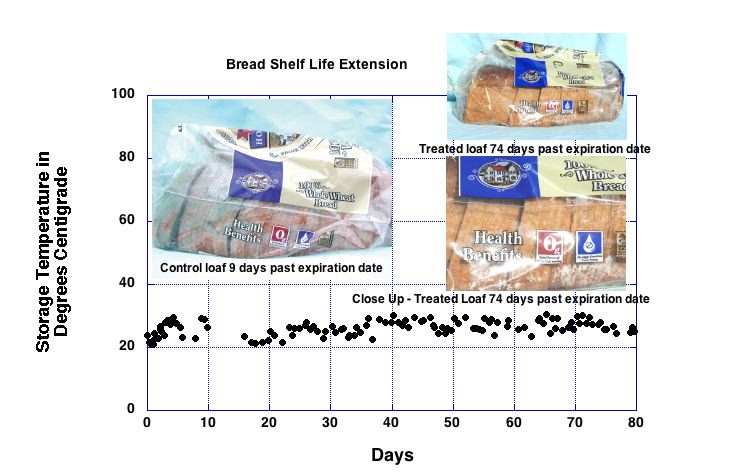The human race has had a very long relationship with bread and manufactures this foodstuff from a variety of grains and in a bewildering variety of forms, flavors, textures and shapes. Bread is a rather unusual food product, however familiar it may be to all of us.
The fact of the matter is that the shelf life of most breads is rather short. Check the expiration date on the breads in the supermarket and one is likely to find a time period of seven to ten days. Such a short shelf life really cuts into the profit margins of the bakeries producing the bread. The distribution system must be very finely honed and run at (unprofitable) speed because the product is losing value very quickly indeed. Even a relatively inexpensive "supermarket" loaf that is worth perhaps three dollars when fresh will be worth essentially nothing on its expiration date. Many bakeries therefore go to the considerable expense of maintaining discount retail establishments expressly designed to extract maximum value from unsold bread which is nearing its expiration date. Pig farmers are quite aware of this situation because expired bread often becomes "almost free" pig feed.
What would happen if the shelf life of bread could be extended from a couple of weeks to a couple of months? Bakeries could become larger, with a higher throughput making good use of economies of scale. The cost of a loaf of fresh bread would no longer have to support an extensive and expensive distribution system, which would bring the cost of a loaf of bread down for the consumer. Neither would the cost of a loaf of fresh bread have to support the cost of the retail bread thrift shops nor the essentially complete lost value represented by unbought loaves that end up as pig feed. The result of this could be yet another cost savings to the consumer. The advantage to the consumer is clear, since she may well find herself paying for fresh bread what she is now paying at the thrift store for bread fast approaching its expiration date. Bakeries would benefit as well since they would now be free to convert a portion of their (now excess) capacity to the manufacture of novel, higher value, products. Pig farmers might not be too happy, though.
Food Safety Analysis offers for sale, as a trade secret, a process that extends the shelf life of bread from the usual ten days to about two and a half months. Given the rather sorry state of the United States Patent Office (USPTO), it is not likely that this process will ever be patented. Please see the figure below:

Several things are evident from this figure. One is that the bread storage temperature was relatively high as this experiment was conducted in the middle of summer. Indeed, the temperature was close to the optimal for the growth of mold, a common contaminant of breads. The second point is that neither the treated nor the control loaves were ever taken out of their original packaging. The third point is that even after an incubation period of 74 days past its expiration date, in a relatively warm environment, the treated loaf still showed approximately the same moisture content as was present in the beginning of the experiment. This is estimated from the very rapid development of condensation evident on the inside of the plastic bag as the loaf was taken from its warm incubation site to the (cooler) photographic studio. The last point clearly seen is that the shelf life of this bread had been quite accurately estimated by the manufacturer. Mold appeared on the control loaf just a few days beyond the expiration date. By the time the control loaf had aged to nine days past its expiration date, the entire loaf was quite rank with mold. Indeed, the control loaf was thrown out as soon as its picture was taken, as there seemed no further reason to keep it.
The treated loaf, on the other hand, has never shown any evidence of microbial contamination and remains free of microbial contamination to this day. However, the packaging was simply a custom-imprinted plastic bag closed with a wire tie. After about two and a half months, the bread began to dry out. Prior to that, the bread seemed as soft and springy as it was when fresh, well before its expiration date.
Anyone who wishes to acquire this trade secret may send an e-mail to mikem@foodsafetyanalysis.com. I am willing to sell to either a single company or to a consortium of companies. Of course, once this trade secret is sold, it is off the market since the buyer will want to use it to advance her own business. In the meantime, anyone who wishes to participate in further experimentation on this process is welcome to do so. Please send me details of the experimental regimen you propose. I would welcome the opportunity to acquire additional date.
Bakers who wish to make use of this process without acquiring the trade secret for themselves may contact me to set up an arrangement whereby they will send their bakery products here. Food Safety Analysis will, for a fee, process these using the trade secret process. After processing, participants may take up their loaves and distribute them how they will. Of course, this arrangement is temporary, as it must be made moot once the trade secret is sold to a buyer.
Copyright © 2012 by M. Mychajlonka, Ph. D.